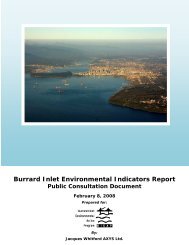Biodiversity Conservation - the BIEAP and FREMP Website
Biodiversity Conservation - the BIEAP and FREMP Website
Biodiversity Conservation - the BIEAP and FREMP Website
Create successful ePaper yourself
Turn your PDF publications into a flip-book with our unique Google optimized e-Paper software.
Breakout Sessions Concerning <strong>the</strong> Ten Strategic Directions | Key Points<br />
Anthopleura elegantissima or pink-tipped<br />
anemone, is <strong>the</strong> most abundant species of sea<br />
anemone found on rocky, tide swept shores<br />
along <strong>the</strong> west coast of North America, from<br />
Alaska to Baja California. Recent studies on <strong>the</strong><br />
medicinal properties of pink-tipped anemone<br />
tissue have demonstrated some anti-tumour<br />
properties but more research is needed.<br />
2<br />
Legislation <strong>and</strong> Regulation continued<br />
Comments about Tactics continued<br />
We should use <strong>the</strong> legislation we have to move<br />
biodiversity conservation forward, but use it in more<br />
innovative ways.<br />
We need to link biodiversity to infrastructure <strong>and</strong><br />
development issues. Then look at every infrastructure<br />
<strong>and</strong> development clause in municipal acts that could be<br />
a lever to protecting biodiversity.<br />
Key to issues of legislation is enforcement. The<br />
legislation is <strong>the</strong>re, <strong>and</strong> it isn’t even being used.<br />
Riparian setbacks (Riparian Areas Regulation)<br />
st<strong>and</strong>ards should maintain <strong>the</strong> salmon resource—that’s<br />
<strong>the</strong> <strong>the</strong>ory—but this has yet to be done region wide, or<br />
even in a municipality.<br />
Strategic Directions for <strong>Biodiversity</strong> <strong>Conservation</strong> in <strong>the</strong> Metro Vancouver Region | Forum Proceedings: Key Points <strong>and</strong> Potential Action Steps<br />
Riparian guidelines are great; we can use <strong>the</strong>m<br />
for salmon. If you protect for salmon, you are also<br />
protecting for o<strong>the</strong>r species.<br />
We need a stronger Species at Risk act.<br />
There are gaps in <strong>the</strong> Species at Risk Act. Municipal<br />
involvement in <strong>the</strong> upcoming review is a priority.<br />
10<br />
Legislation <strong>and</strong> regulation played a crucial role<br />
in <strong>the</strong> recovery of California sea lions, Zalophus<br />
californianus. In <strong>the</strong> early 1940’s commercial fishing<br />
was curtailed <strong>and</strong> in <strong>the</strong> 1970’s DDT was banned<br />
<strong>and</strong> <strong>the</strong> Canadian Federal Fisheries Act <strong>and</strong> <strong>the</strong><br />
U.S. Marine Mammal Protection Acts were passed<br />
prohibiting <strong>the</strong> killing of California sea lions. They<br />
are abundant today, however scientists are alarmed<br />
with significant cases of cancer in <strong>the</strong> species.<br />
Environmental pollutants are <strong>the</strong> prime suspect.
















